What Does White Thistle on a Family Crest Mean
| Royal glaze of arms of the U.k. | |
|---|---|
 | |
| Versions | |
 Version of the regal glaze of artillery used in Scotland | |
 The banner of arms, which serves equally a royal standard | |
 The banner of arms, which serves as a royal standard in Scotland | |
| Armiger | Elizabeth Two in Right of the Uk |
| Adopted | 1837 |
| Crest | Upon the helm, a royal crown proper thereon a lion statant guardant Or langued Gules armed Silvery, royally crowned Proper; mantled Or doubled Ermine |
| Blazon | Quarterly, I and IV Gules, three lions passant guardant in stake Or langued and armed Azure. 2 Or a lion rampant Gules armed and langued Azure within a double tressure flory-counter-flory Gules. Iii Azure a harp Or stringed Silvery.; quarters for England and Scotland are exchanged in Scotland. |
| Supporters | On the dexter a panthera leo rampant guardant Or langued and armed Gules, royally crowned Proper. On the sinister a Unicorn rampant Argent armed crined and unguled Or, and gorged with a Coronet composed of crosses patee and fleurs-de-lis, a chain affixed thereto passing through the forelegs and reflexed over the back Or |
| Compartment | Tudor rose, Shamrock, and Thistle |
| Motto | French: Dieu et mon droit, lit.'God and my correct' |
| Social club(due south) | Social club of the Garter |
| Earlier version(s) | meet below |
| Employ | On all Acts of Parliament; the cover of all United kingdom of great britain and northern ireland passports; various government departments; adapted for the reverse of coins of the pound sterling (2008) |
The royal coat of arms of the United Kingdom, or the regal artillery for short, is the arms of dominion of the British monarch,[i] [2] currently Queen Elizabeth II. These arms are used by the Queen in her official chapters as monarch of the United kingdom. Variants of the royal artillery are used past other members of the British royal family, by the British Government in connection with the administration and government of the country, and some courts and legislatures in a number of Commonwealth realms. A Scottish version of the royal arms is used in and for Scotland. The arms in imprint form serve as basis for the monarch'southward official flag, the Royal Standard.
In the standard variant used exterior of Scotland, the shield is quartered, depicting in the commencement and fourth quarters the three passant guardant lions of England; in the second, the rampant lion and double tressure flory-counterflory of Scotland; and in the third, a harp for Republic of ireland.[3] The crest is a statant guardant lion wearing the St Edward's Crown, himself on another representation of that crown. The dexter supporter is a likewise crowned English lion; the sinister, a Scottish unicorn. The English language and Scottish quarters and supporters are swapped in the Scottish version of the artillery.
In the greenery below, a thistle, Tudor rose and shamrock are depicted, representing Scotland, England and Ireland respectively. This armorial accomplishment comprises the motto, in French, of English monarchs, Dieu et mon droit (God and my right), which has descended to the present purple family unit as well equally the Garter circlet which surrounds the shield, inscribed with the Social club's motto, in French, Honi soit qui mal y pense (Shame on him who thinks evil of it). In the arms as used in Scotland, the Guild of the Thistle's motto, Nemo me impune lacessit (No 1 provokes me with impunity) is used. The official type of the royal arms is:
Quarterly, first and fourth Gules three Lions passant gardant in pale Or armed and langued Azure (for England), 2d quarter Or a Panthera leo rampant within a double tressure flory-counter-flory Gules (for Scotland), third quarter Azure a Harp Or stringed Argent (for Republic of ireland), the whole surrounded past the Garter; for a Crest, upon the Royal captain the Imperial Crown Proper, thereon a Lion statant gardant Or imperially crowned Proper; Mantling Or and Ermine; for Supporters, dexter a Lion rampant gardant Or crowned as the Crest, sinister a Unicorn Silvery armed, crined and unguled Proper, gorged with a Coronet Or equanimous of Crosses patées and Fleurs-de-lis a Chain affixed thereto passing between the forelegs and reflexed over the back also Or. Motto " Dieu et mon Droit " in the compartment below the shield, with the Union Rose, Shamrock and Thistle engrafted on the same stalk.[three]
Uses [edit]
The purple artillery may only be used past the Queen herself. They likewise appear in courtrooms, since the monarch is deemed to be the fount of judicial authority in the United kingdom and law courts contain office of the ancient royal courtroom (thus so named).[4] Judges are officially Crown representatives, demonstrated by the display of the royal artillery backside the approximate's bench in courts in England and Wales; which notable exceptions include the Supreme Court of the United Kingdom, which displays its own badge and flag to symbolize its nationwide part, the magistrates' court in the City of London, where behind the Justices of the Peace stands a sword upright flanked past the arms of the City and the Crown. In addition, the purple arms cannot be displayed in courtrooms or on court-business firm exteriors in Northern Ireland, except for the courtrooms of the Royal Courts of Justice in Belfast and the courts in Armagh, Banbridge, Downpatrick, Magherafelt, or Omagh, and the exterior of court buildings that had them in identify prior to the 2002 law.[5]
Equally the United Kingdom is governed in the monarch's proper name, the British Authorities besides uses the royal arms as a national symbol of the U.k.,[6] and, in that chapters, the coat of arms can be seen on several government documents and forms, passports, in the entrance to embassies and consulates, etc. Nonetheless, when used by the government and not by the monarch personally, the coat of artillery is often represented without the helm. This is the example with both the Scottish and not-Scottish versions.
The royal arms take regularly appeared on the coinage produced past the Royal Mint including, for instance, from 1663, the Guinea and, from 1983, the British one pound coin. In 2008, a new series of designs for all seven coins of £one and below was unveiled by the Majestic Mint, every one of which is drawn from the royal artillery. The full royal arms announced on the one pound coin, and sections announced on each of the other six, such that they tin be put together like a puzzle to make some other complete representation of the royal arms.[vii] The serial was replaced in 2016 past the Nations of the Crown bi-metallic coin.
The monarch grants Imperial Warrants to select businesses and tradespeople which supply the Majestic Household with goods or services. This entitles those businesses to display the royal artillery on their packaging and stationery by way of advertizement.
It is customary (merely not mandatory) for churches throughout the U.k. whether in the Church of England or the Church of Scotland to display the royal arms to show loyalty to the Crown.[viii] [9] If a church building of either denomination does non have a majestic arms, permission from the Crown must be given before i can be used.[10]
A banner of the royal artillery, known as the Royal Standard, is flown from the royal palaces when the monarch is in residence, Windsor Castle and Buckingham Palace being her principal abodes; and from public buildings merely when the monarch is present. For instance, the Royal Standard only flies over the Palace of Westminster when the monarch is delivering her spoken language from the throne in the House of Lords at the State Opening of Parliament. This protocol every bit applies to the monarch'south principal residences in Scotland (the Palace of Holyroodhouse and Balmoral Castle), where the Royal Standard (Scottish version) is flown. When the monarch is non in residence the Union Flag, or in Scotland the aboriginal Majestic Standard of Scotland, is flown.
The widely sold British newspaper The Times uses the Hanoverian royal arms as a logo, whereas its sister publication, The Sun Times, displays the current version. Besides, the Australian newspaper The Historic period uses the insignia equally its logo.
The imperial arms are besides displayed in all courts in British Columbia, as well as in other Canadian provinces such as Ontario, where the judges are appointed past Crown potency.[11] In Australia they were also displayed by all Viceroys as representation of their Crown authorization, and past well-nigh land Supreme Courts across the land. Additionally the Western Australian Legislative Council has also adopted them as its own symbol.
The royal arms were controversially used past former Prime Government minister Margaret Thatcher as her official letterhead from c. 1997.[12]
Scotland [edit]

Since the Wedlock of the Crowns in 1603, a divide version of the royal artillery has been used in Scotland, giving the Scottish elements pride of place.
The shield is quartered, depicting in the first and 4th quarters the lion rampant of Scotland; in the 2nd, the three lions passant guardant of England; and in the third, the harp of Republic of ireland.
The crest atop the Crown of Scotland is a cherry lion, seated and forward facing, itself wearing the Crown of Scotland and belongings the 2 remaining elements of the Honours of Scotland, namely the Sword of Country and the Sceptre of Scotland. This was as well the crest used in the regal arms of the Kingdom of Scotland. The slogan, in Scots, appears higher up the crest, in the tradition of Scottish heraldry, and is an abbreviated form of the total motto: In My Defens God Me Defend.
The supporters modify sides and both announced wearing the crowns of their respective Kingdom. The dexter supporter is a crowned and chained unicorn, symbolising Scotland. The sinister supporter is a crowned lion, symbolising England. Between each supporter and the shield is a lance displaying the flag of their respective Kingdom.
The coat too features both the motto Nemo me impune lacessit (No i wounds (touches) me with impunity) and, surrounding the shield, the collar of the Order of the Thistle. On the compartment are a number of thistles, Scotland's national bloom.
England, Wales and Northern Ireland [edit]

Majestic arms of Elizabeth II, displayed in the parish church of Stone, Kent
Unlike the Acts of Marriage 1707 with Scotland, the Acts of Union 1800 with Ireland did not provide for a dissever Irish gaelic version of the royal arms.[ dubious ] The crest of the Kingdom of Ireland ("on a wreath Or and Azure, a belfry triple-towered of the First, from the portal a hart springing Silver attired and unguled Or") has had little or no official use since the union.
The harp quarter of the purple arms represents Ireland on both the English and Scottish versions. Besides, ane English quarter is retained in the Scottish version, and one Scottish quarter is retained in the English version. Thus, England, Scotland and Ireland are represented in all versions of the royal artillery since they came under one monarch. When the Irish Gratis Land established its own diplomatic seals in the 1930s, the purple arms appearing on them varied from those on their UK equivalents by having the Irish gaelic arms in two-quarters and the English arms in one.[13] Past contrast, there is no representation at all for Wales in the majestic arms, as at the Human activity of Union 1707 Wales was an integral part of the Kingdom of England pursuant to the Laws in Wales Acts 1535 and 1542; thus, it has been argued Wales is represented in the English coat of arms. Still the argument is somewhat disingenuous as in 1535 the Welsh Dragon was already part of the Tudor Coat of Arms. Upon the accession of the Tudor monarchs, who were themselves of Welsh descent, a Welsh Dragon was used as a supporter on the royal arms. This was dropped by their successors, the Scottish House of Stuart, who replaced the Tudors' dragon supporter with the Scottish unicorn. In the 20th century, the arms of the principality of Wales were added as an inescutcheon to the coat of arms of the Prince of Wales, and a banner of those arms with a green inescutcheon bearing the prince's crown is flown as his personal standard in Wales. The and so-called Prince of Wales'southward feathers are a heraldic badge rather than a glaze of artillery upon a shield, just they are not Welsh in any case. They derive, in fact, from the English language Princes of Wales (who may owe them to an exploit of Edward, the Black Prince at the Battle of Crécy) and carry the motto Ich dien (German, "I Serve"). In whatever event, they practise not course function of the royal arms, as opposed to the heraldic achievement of the Prince of Wales, who drops them upon his accretion as King.
History [edit]
Kingdoms of England and Scotland [edit]
The current royal artillery are a combination of the arms of the former kingdoms that make up the Uk, and can be traced dorsum to the first arms of the kings of England and kings of Scotland. Various alterations occurred over the years every bit the arms of other realms acquired or claimed by the kings were added to the royal arms. The tabular array below tracks the changes in the majestic arms from the original arms of Male monarch Richard I of England, and William I, King of Scots.
| Kingdom of England | Kingdom of Scotland | |||||||||||||||||||||||||||||||||||||||||||||||||||||||||
|
|
Union of the Crowns and the Commonwealth [edit]
| The Union of the Crowns places England, Ireland and Scotland nether ane monarch | ||
| Arms | Dates | Details |
|---|---|---|
| | 1603–1649* | James Half dozen, King of Scots, inherited the English and Irish thrones in 1603 (Marriage of the Crowns), and quartered the majestic arms of England with those of Scotland. For the beginning time, the Royal Coat of Arms of Republic of ireland was added to represent the Kingdom of Ireland.[3] The Scottish version differs in giving the Scottish elements precedence. *Utilize of the Scottish version, together with the monarchy nether Charles II, continued in Scotland during the period 1649–1651. |
| | 1649–1654 | These novel artillery, already in use past parliamentarians in 1648, were adopted by the Commonwealth of England established in 1649.[18] |
| | 1654–1655 | The Democracy of England, Scotland and Ireland (the Protectorate) was created in 1653. St Andrew's Cross was added to the arms in 1654.[19] |
| | 1655–1659 | The artillery of the Commonwealth from 1655 to 1659. Struck in 1655, the Great Seal included the personal arms of Oliver Cromwell on a shield in the center.[3] Type: Quarterly i and 4 Argent a Cantankerous Gules (England) 2 Azure a Saltire Silvery (Scotland) and iii Azure a Harp Or Stringed Argent (Ireland) on an Inescutcheon Sable a Lion Rampant Silverish (Cromwell's arms). The supporters were a crowned panthera leo of England and a red dragon of Wales. The Scottish unicorn was removed, as it was associated with the Stuart Monarchy. The motto read PAX QUÆRITUR BELLO ("peace is obtained through war").[xx] |
| | 1659–1660 | Following the Protectorate, the 1654 artillery were restored. |
| | 1660–1689 | Charles Ii restored the royal arms following the restoration after the civil wars. |
| | 1689–1694 | Rex James II & Seven is deposed and replaced with his girl Mary II and her husband, William Iii. As King and Queen they impaled their arms: William bore the royal arms with an escutcheon of Nassau (the royal house to which William belonged) added (a golden lion rampant on a blue field with golden billets), while Mary bore the royal artillery undifferenced.[21] [22] |
| | 1694–1702 | After the death of Mary Two, William Three reigned alone, and used his artillery simply.[3] [21] |
| | 1702–1707 | Queen Anne inherited the throne upon the death of King William Three & II, and the royal arms returned to the 1603 version.[three] |
Subsequently the Acts of Matrimony 1707 [edit]
| At the Spousal relationship creating Nifty United kingdom of great britain and northern ireland in 1707, artillery were adopted for the new kingdom, and again in 1801 at the Union creating the United Kingdom | ||||
| Arms | Dates | Details | ||
|---|---|---|---|---|
| | 1707–1714 |
| ||
| | 1714–1800 |
| ||
| | 1801–1816 |
| ||
| | 1816–1837 |
| ||
| | 1837–1952 |
| ||
| | 1952–present | The Irish harp was modified to a apparently Gaelic harp, rather than a winged female [as above], in 1952 in accordance with the personal preference of Queen Elizabeth.[23] The royal arms do non incorporate whatever specific chemical element for Wales, a principality, incorporated into the Kingdom of England under Henry VIII. | ||
Other variants [edit]
Purple family [edit]
Members of the British purple family are granted their ain personal arms. In the past, the monarch'southward younger sons used various differences; and married daughters of the monarch impaled the plain regal arms with their husbands' artillery. But for many centuries at present, all members of the royal family have had differenced versions of the royal artillery settled on them by Royal Warrant.[24] Merely children and grandchildren in the male person line of the monarch are entitled to arms in this mode: the arms of children of the monarch are differenced with a three-betoken label; while grandchildren of the monarch are differenced with a five-point characterization. An exception is made for the eldest son of the Prince of Wales, who as well bears a three-signal characterization. The labels are always white (argent) and each prince or princess has private marks to class his or her particular difference, except the Prince of Wales, who uses a plainly white iii-pointed characterization.[24] Since 1911, the arms of the Prince of Wales also displays an inescutcheon of the aboriginal artillery of the Principality of Wales. The incumbent, Charles, Prince of Wales, afterwards becoming the heir apparent in 1952, did not use the inescutcheon until he was officially created Prince of Wales in 1969.[24]
Queens consort and the wives of sons of the monarch likewise have their own personal glaze of arms. Typically this volition be the arms of their hubby impaled with their own personal arms or those of their begetter, if armigerous. However, the consorts of a queen regnant are not entitled to utilise the regal artillery. Thus Prince Philip, Duke of Edinburgh was granted his own personal artillery. A notable exception to this dominion was Prince Albert, who used the majestic arms (differenced past a special label) quartered with his own Saxon royal artillery.[24]
Currently the post-obit members of the regal family have their own arms based on the majestic arms:
| Children and grandchildren of the monarch in the male line | |||
| Armorial achievement | Shield | Bearer | Difference(southward) |
|---|---|---|---|
 |  | Charles, Prince of Wales, exterior Scotland | The glaze of arms of the Prince of Wales is based on the royal arms with the plainly 3-point label, augmented by an inescutcheon in honour of the traditional arms of the Principality of Wales.[3] The Prince of Wales'due south feathers, the Crimson Dragon of Wales, Sable xv Bezants Or (the arms of the Knuckles of Cornwall, his subsidiary title in England) and his motto Ich dien are likewise added below the shield and the supporters. In Scotland, his arms as the Knuckles of Rothesay are displayed rather than those of the Prince of Wales. |
 |  | Charles, Duke of Rothesay, in Scotland | Used in Scotland, the artillery of the Duke of Rothesay are those of Clan Stewart of Appin adapted, namely the quartered arms of the Prince and Smashing Steward of Scotland and Lord of the Isles (secondary titles of the Duke) with an inescutcheon every bit Scottish heir apparent (the Royal Artillery of Scotland with a bluish 3-signal label). |
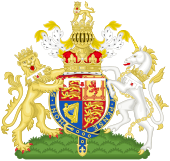 |  | Prince William, Duke of Cambridge | Three-bespeak characterization with a red escallop, alluding to the patrilineal artillery of his mother, Diana, Princess of Wales.[25] |
 |  | Prince Harry, Duke of Sussex | Five-point label with 3 red escallops in alternate points, alluding to the patrilineal artillery of his female parent, Diana, Princess of Wales.[25] |
 |  | Anne, Princess Royal | Iii-betoken label, the points bearing a ruby-red cross, a carmine heart and a cherry cross.[3] |
 | 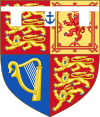 | Prince Andrew, Knuckles of York | Three-point label, the centre indicate bearing a bluish anchor.[3] |
 |  | Princess Beatrice, Mrs Edoardo Mapelli Mozzi | Five-point label with three bees in alternate points. |
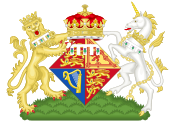 | 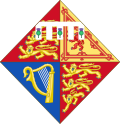 | Princess Eugenie, Mrs Jack Brooksbank | Five-point label with three thistles in alternate points. |
 |  | Prince Edward, Earl of Wessex | Three-point characterization, the center point begetting a Tudor rose. |
 |  | Prince Richard, Duke of Gloucester | V-point label, the first, 3rd and fifth points bearing a cherry cross, the second and 4th points begetting a cerise king of beasts.[three] |
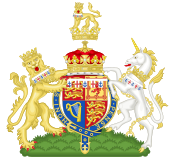 |  | Prince Edward, Knuckles of Kent | Five-point label, the offset, tertiary and fifth points begetting a bluish ballast, the second and 4th points bearing a scarlet cantankerous.[iii] |
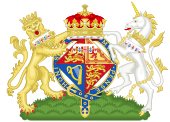 |  | Princess Alexandra, The Hon. Lady Ogilvy | V-indicate label, the first and fifth points bearing a ruby-red eye, the second and fourth points begetting a blue ballast, and the third bearing a red cross.[3] |
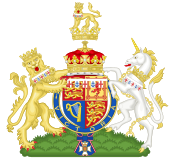 |  | Prince Michael of Kent | Five-betoken label, the first, third and fifth points bearing a ruby cantankerous, the 2nd and fourth points bearing a blue ballast.[iii] |
| Consorts | |||
 |  | Camilla, Duchess of Cornwall | The arms of the Prince of Wales impaled with those of her father, Major Bruce Shand, crowned with the single-arched Coronet of Prince of Wales.[26] |
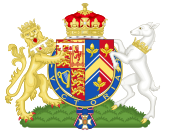 | 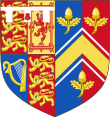 | Catherine, Duchess of Cambridge | The arms of the Duke of Cambridge impaled with those of her father, Michael Middleton, crowned with the coronet of a child of the heir-apparent.[27] |
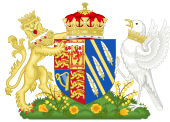 |  | Meghan, Duchess of Sussex | The arms of the Knuckles of Sussex impaled with those of her own blueprint, crowned with the coronet of a child of the heir-apparent.[28] |
 |  | Sophie, Countess of Wessex | The arms of the Earl of Wessex impaled with those granted in 1999 to her father, Christopher Rhys-Jones, with remainder to his elderberry brother Theo. The new grant was based on an unregistered 200-year-old design. The panthera leo alludes to ane of the Countess' ancestors the Welsh knight Elystan Glodrydd, prince of Ferrig.[29] |
 |  | Birgitte, Duchess of Gloucester | The arms of the Duke of Gloucester with an escutcheon of pretence granted to her by Royal Warrant on xviii July 1973.[30] |
 |  | Katharine, Duchess of Kent | The arms of the Knuckles of Kent impaled with those of her father, Sir William Arthington Worsley, fourth Baronet. |
 |  | Princess Michael of Kent | The arms of Prince Michael of Kent impaled with those of her begetter, Baron Günther Hubertus von Reibnitz. |
Authorities [edit]



A version used past the British government on official websites and departmental insignia
Various versions of the purple arms are used by Her Majesty's Government in the United Kingdom, the Parliament of the United Kingdom and courts in some parts of the Commonwealth.
HM Government more often than not uses a simplified version of the royal arms with a crown replacing the captain and crest, and with no compartment.[31] In relation to Scotland, the Scotland Role and the Advocate General for Scotland utilize the Scottish version, once again without the captain or crest, and the aforementioned was used every bit the day-to-day logo of the Scottish Executive until September 2007, when a rebranding exercise introduced the name Scottish Authorities, together with a revised logo incorporating the flag of Scotland.[32]
The Scottish Government continues to utilize the Arms on some official documents.
The simplified royal artillery also feature:
- on all Acts of Parliament;
- on the cover of all U.k. passports and passports issued in other British territories and dependencies;
- every bit an inescutcheon on the diplomatic flags of British Ambassadors; and
- on all acts of the Anguilla House of Associates, the Sovereign Base of operations Areas, Pitcairn Islands and South Georgia and the South Sandwich Islands administrations;
- on The London Gazette.
Various courts in the Commonwealth also continue to use the royal arms:
- The Courtroom of Appeal, Supreme Court and Provincial Court of British Columbia[33] [34]
- The Supreme Courtroom of Newfoundland and Labrador[35] and Court of Entreatment of Newfoundland and Labrador[36]
- The Supreme Court of the Yukon Territory[37]
- The Supreme Court of South Commonwealth of australia[38]
- The Supreme Courtroom of Victoria[39]
Furthermore:
- A version of the crest of the imperial arms, as used in Scotland, is used by the Crown Office and Procurator Financial Service, the General Register Part for Scotland and the Purple Commission on the Aboriginal and Historical Monuments of Scotland.
- The crowned shield of the royal arms encircled by the Garter is used by the Domicile Function, past the Privy Council Office (Great britain), and past the Parliament of Victoria.[40]
- The crowned shield of the royal arms is used past the Regal Mint.
- The royal arms with the crest but without the captain is used as the rank insignia for Grade 1 Warrant Officers in Her Majesty'due south War machine.
Type [edit]
This tabular array breaks downwards the official blazons to enable comparison of the differences between the full general coat and the coat used in Scotland.
| Everywhere except Scotland | Scotland | |
|---|---|---|
| Quarterly I & 4 | Gules three lions passant gardant in pale Or armed and langued Azure | Or a panthera leo rampant Gules armed and langued Azure within a double tressure flory-counter-flory of the second |
| Quarterly 2 | Or a lion rampant Gules armed and langued Azure within a double tressure flory-counter-flory of the second | Gules three lions passant gardant in stake Or armed and langued Azure |
| Quarterly Iii | Azure a harp Or stringed Argent | |
| Surrounded by | The Garter circlet | The neckband of the Club of the Thistle |
| Crest | Upon the Royal captain the purple crown Proper, thereon a king of beasts statant gardant Or imperially crowned Proper | Upon the Royal helm the crown of Scotland Proper, thereon a king of beasts sejant affronté Gules armed and langued Azure, Royally crowned Proper holding in his dexter manus a sword and in his sinister a sceptre, both Proper |
| Supporters | Dexter a lion rampant gardant Or imperially crowned Proper, sinister a unicorn Silverish, armed, crined and unguled Or, gorged with a coronet Or composed of crosses patée and fleurs de lis a concatenation affixed thereto passing between the forelegs and reflexed over the back likewise Or | Dexter a unicorn Argent Royally crowned Proper, armed, crined and unguled Or, gorged with a coronet Or composed of crosses patée and fleurs de lis a chain affixed thereto passing betwixt the forelegs and reflexed over the back also Or belongings the standard of Saint Andrew, sinister a lion rampant gardant Or imperially crowned Proper holding the standard of Saint George |
| Motto | Dieu et mon Droit (French) | In My Defens God Me Defend, abbr. In Defens (Scots) |
| Society Motto | Garter: Honi soit qui mal y pense (Old French) | Thistle: Nemo me impune lacessit (Latin) |
| Plants on the compartment | Roses, thistles and shamrocks (on the same stem) | Thistles only |
Run across besides [edit]
- Flag of the United Kingdom
- Cadency labels of the British royal family unit
- Armorial of the Business firm of Plantagenet
Of all the sometime Dominions just three retain elements from the British Coat of Arms:
- Coat of arms of New Zealand
- Arms of Canada
- Coat of arms of Newfoundland and Labrador
Republic of ireland uses the medieval artillery of Ireland that are incorporated into the British Coat of Artillery:
- Glaze of arms of Ireland
All other onetime Dominions have changed their glaze of arms:
- Glaze of artillery of Commonwealth of australia
- Coat of artillery of Southward Africa
- Emblem of India
- Keepsake of Sri Lanka
References [edit]
- ^ "Coats of arms". The Royal Household. 15 January 2016. Retrieved 3 Oct 2020.
- ^ p. 10, Government identity organisation (2012). HM Government. "The Queen is Head of State, and the United Kingdom is governed by Her Majesty's Government in the name of the Queen. The royal coat of arms is personal to the Queen and..."
- ^ a b c d e f g h i j k l m n o p q r s t u five w x Brooke-Trivial, J. P. (1978) [1950]. Boutell's Heraldry (Revised ed.). London: Frederick Warne LTD. pp. 205–222. ISBN0-7232-2096-4.
- ^ "Traditions of the courts". Courts and Tribunals Judiciary . Retrieved 2 January 2017.
- ^ Justice (Northern Ireland) Deed 2002 (c.26) 66 Display of Imperial Arms at courts
- ^ Government identity system HM Authorities
- ^ The New Designs Revealed Archived 4 April 2008 at the Wayback Machine
- ^ Treasures of United kingdom and Treasures of Ireland (1976 ed.). Drive Publications. p. 677. Retrieved 15 March 2014.
- ^ "Royal Arms in church". Intriguing History. thirty May 2013. Retrieved 31 July 2015.
- ^ Hasler, Charles (1980). The Purple Arms — Its Graphic And Decorative Evolution . Jupiter Books. ISBN978-0904041200.
- ^ Welcome [ dead link ]
- ^
- ^ Hanley, Hugh (2015). "'The Concluding Shadow': Negotiating the Great Seal and Directly Access to the Male monarch, 1931". Irish gaelic Studies in International Affairs. Royal Irish gaelic University. 26: 257–274 : 266. doi:10.3318/isia.2015.26.xiii. JSTOR 10.3318/isia.2015.26.13. ; Walshe, Joseph (26 October 1937). "Memorandum on external seals". Documents on Irish Foreign Policy, Vol. V No. 97. Imperial Irish gaelic Academy. Retrieved xx September 2011.
- ^ heraldica.org. Heraldica. Retrieved ii June 2020.
- ^ a b c d The Franco-Scots Coinage of Mary Stuart and Francis II Archived 26 February 2008 at the Wayback Machine
- ^ Elizabeth and Mary, Purple Cousins, Rival Queens: Curators' Picks, British Library, eight October 2021
- ^ Scottish Coins ~ Mary (1542–1567) [ expressionless link ]
- ^ Petchey, W.J., Massachusetts (1967). A Short Account of the Armorial Bearings of the Sovereigns of England. London: National Quango of Social Service.
- ^ Scotland was formally reunited with England past an Ordinance of 12 April 1654 which ordered: "That the artillery of Scotland viz: a Cross unremarkably called the St Andrew's Cross be received onto and borne from henceforth in the Arms of this Commonwealth ... etc". 'April 1654: An Ordinance for uniting Scotland into one Commonwealth with England.', Acts and Ordinances of the Interregnum, 1642–1660 (1911), pp. 871–875. URL: http://www.british-history.ac.uk/study.aspx?compid=56540&strquery=arms Date accessed: 1 January 2011.
- ^ Friar, Basic Heraldry (1993).
- ^ a b François Velde's Heraldica site
- ^ Arnaud Bunel's Héraldique européenne site [ dead link ]
- ^ British Royal Standards since 1801 David Prothero and Martin Grieve. Retrieved 13 May 2011.
- ^ a b c d Moncreiffe, Iain; Pottinger, Don (1954). Uncomplicated Heraldry Cheerfully Illustrated. Thomas Nelson and Sons. pp. twoscore–41.
- ^ a b College of Arms. "Higher of Arms – the coat of arms of TRH Prince William and Prince Henry of Wales". Archived from the original on 27 May 2008. Retrieved 17 April 2010.
- ^ "Camilla's glaze of arms unveiled". 17 July 2005 – via news.bbc.co.united kingdom of great britain and northern ireland.
- ^ "Coat of Arms of Duchess of Cambridge". dukeandduchessofcambridge.org. 14 November 2012. Archived from the original on 6 November 2012.
- ^ "Her Imperial Highness The Duchess of Sussex: Coat of Arms". The Royal Family. 25 May 2018. Retrieved 25 May 2018.
- ^ Sophie'south new coat. BBC News. 19 May 1999. Retrieved 14 Nov 2010.
- ^ Boutell, Charles; Brooke-Little, John Philip (1978). Boutell'due south Heraldry (eighth revised ed.). Frederick Warne. p. 226. ISBN9780723220961.
- ^ GOV.United kingdom, Departments, agencies and public bodies [1]. Retrieved 10 August 2013
- ^ "New Lord Lyon Rex of Arms appointed". v March 2017. Archived from the original on 5 March 2017. Retrieved 29 July 2021.
- ^ "Court of Appeal – Hearing List". www.courts.gov.bc.ca.
- ^ "Provincial Court of British Columbia". www.provincialcourt.bc.ca.
- ^ "Supreme Courtroom of Newfoundland and Labrador". courtroom.nl.ca . Retrieved 29 July 2021.
- ^ "Home". Court of Entreatment of Newfoundland and Labrador . Retrieved 29 July 2021.
- ^ "Supreme Court". www.yukoncourts.ca.
- ^ "SUPREME COURT Human action 1935 – SECT 15". www.austlii.edu.au.
- ^ Victoria, Supreme Court of Victoria, State Government of. "Home". www.supremecourt.vic.gov.au.
- ^ "Parliament of Victoria – Abode". www.parliament.vic.gov.au.
External links [edit]
- Number 10 Downing Street- Royal Coat of Arms
- Heraldica.org- The Royal Arms of Bang-up United kingdom of great britain and northern ireland
- Government identity organisation HM Government
Source: https://en.wikipedia.org/wiki/Royal_coat_of_arms_of_the_United_Kingdom


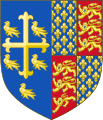



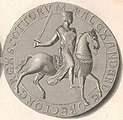
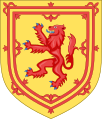




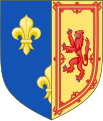
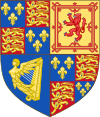


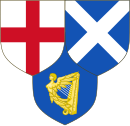


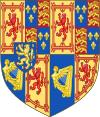

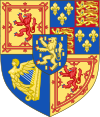




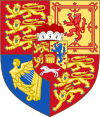


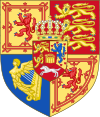




Post a Comment for "What Does White Thistle on a Family Crest Mean"